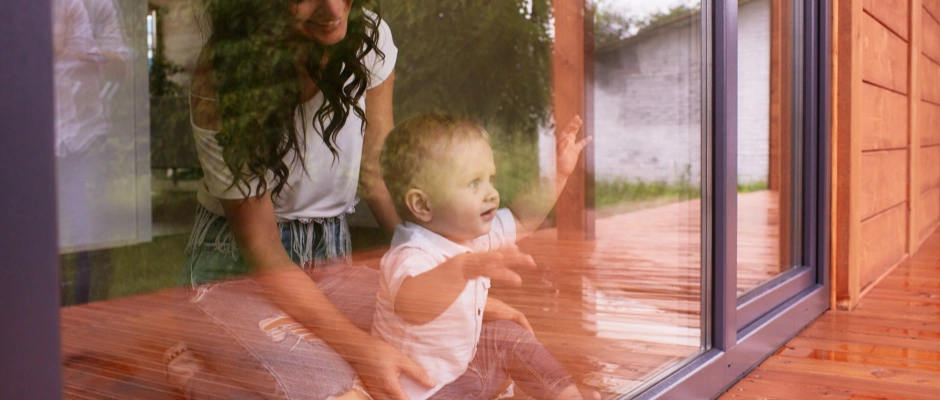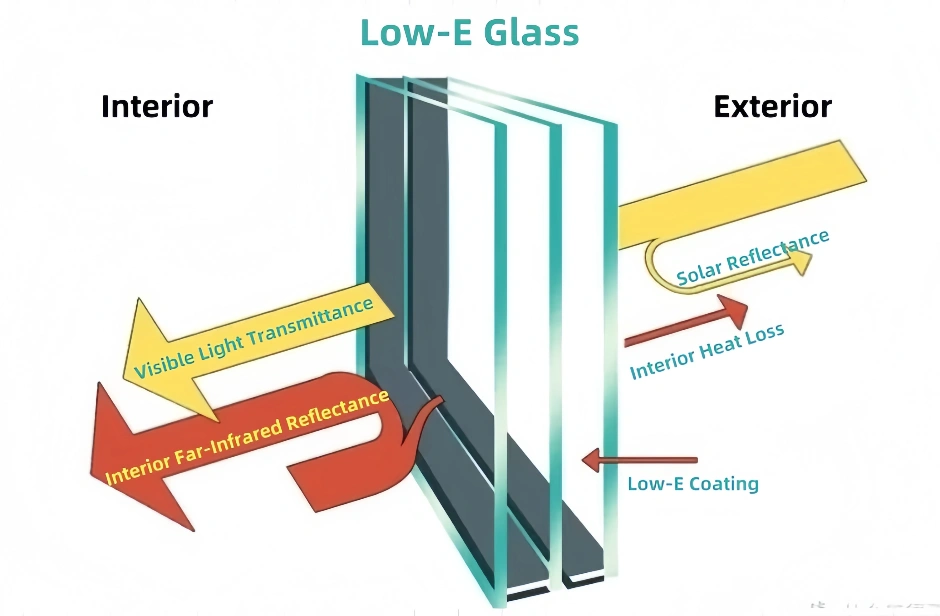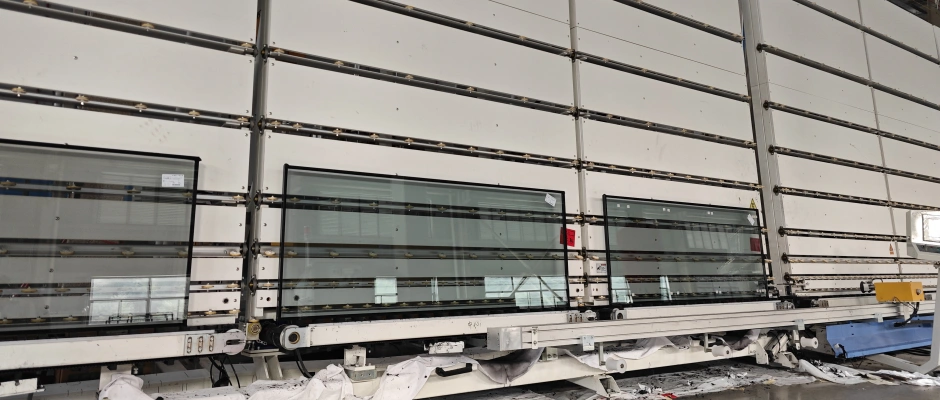
Glass is more than just a window connecting indoors and outdoors. In modern buildings, it’s a key player in saving energy, keeping spaces comfy, and looking great. Among all glass types, Low-E glass shines for its awesome energy-saving powers. What makes its special coating last so long?
Understanding Low-E Coating Technology
Low-E glass, or low-emissivity glass, has a thin layer of metal or compounds on its surface. This layer lets lots of visible light pass through but blocks heat waves, saving energy while keeping rooms bright.

Basics of Low-E Coating
The coating forms through special methods, like spraying or vacuum processes. It does two big jobs. First, it cuts heat swapping between the glass and air, stopping temperature changes from moving heat. Second, it bounces back heat waves, keeping the sun’s heat out. It’s like an invisible jacket for glass, letting light in but holding heat back.
Types of Low-E Coatings
Low-E coatings come in different kinds, based on how they’re made and what they do:
Online Low-E Glass: Made during glass production at high heat, this coating sticks tightly to the glass. It’s tough, scratch-proof, and called “hard coating.” You can even use it alone. But, it’s harder to control its thickness, colors are plain, and its heat-blocking power is a bit weaker (emissivity above 0.15).
Offline Low-E Glass: Made in a separate vacuum process, this coating is super precise. It can have multiple layers to pick which sunlight parts pass through, offering many color options and better heat-blocking (emissivity below 0.15). But it’s softer, less tough against rust, and called “soft coating.” It usually needs to be in insulated glass to stay safe.
Silver-Free Low-E Coating: A new offline breakthrough, this coating resists wear and rust. It can be used indoors, opening up new uses.

How Low-E Insulated Glass Boosts Energy Savings
Low-E glass is often used in insulated glass to save the most energy. Insulated glass has two or more glass panes with a dry air gap between, held by spacers. This gap is sometimes filled with gases like argon.
Why Insulated Glass Saves Energy
1. Low Emissivity: Reducing Heat Transfer
1.1 Reflecting Infrared Radiation
Low-emissivity (Low-E) glass incorporates an ultra-thin metal-based layer with minimal heat-emitting properties. This specialized coating efficiently bounces back infrared energy.
During hot seasons, exterior heat waves transmit thermal energy as infrared waves toward buildings. The Low-E coating acts like a mirror for these IR waves. It deflects much of this radiant heat. This process decreases unwanted warmth entering indoors. As a result, air conditioning systems work less strenuously. This leads to measurable energy conservation.
1.2 Reducing Conductive Heat Transfer
Thanks to its low emissivity, Low-E glass reduces heat transfer caused by temperature differences across the glass. Compared to ordinary glass, Low-E units have significantly lower thermal transmittance (U-values). For example, standard single-pane glass may have a U-value of around 5.8–6.0 W/(m²·K), while Low-E IGUs can achieve U-values as low as 1.6–1.9 W/(m²·K), or even lower, greatly slowing the rate of heat transfer.
2. Insulated Glass Construction: Enhancing Thermal Performance
2.1 Air Gap Insulation
Low-E insulated glass units (IGUs) are composed of two or more panes of glass separated by a dry air or inert gas layer, such as argon. Air is a poor conductor of heat, with a thermal conductivity of approximately 0.024 W/(m·K), compared to 0.76–1.05 W/(m·K) for glass. The insulating air gap acts as a thermal barrier, significantly improving the unit’s resistance to heat transfer.
2.2 Reducing Convective Heat Exchange
The air (or gas) layer in an IGU limits convective movement, thereby reducing heat exchange via convection. Without this gap, heat would transfer more rapidly as indoor and outdoor air flows interact directly with the glass surface. The IGU structure effectively blocks this airflow, further enhancing its energy-saving performance.
3. Optimised System for Maximum Energy Efficiency
3.1 Synergy with Low-E Coating
The insulated structure provides a controlled environment for the Low-E coating, allowing it to perform more effectively.
GLASVUE, a glass solution expert, knows Low-E glass well. They offer full-power double-layer insulated glass for public buildings and high-end homes. Their top-tier triple-layer insulated glass meets 7-star building rules.
New Ideas: Low-E in Mixed Glass Solutions
When Low-E coatings sit inside laminated glass, not touching air, they lose some energy-saving power. They can’t cut heat transfer well, missing their heat-blocking edge. But placing silver-free or online Low-E coatings on the indoor side helps save a lot.
Real breakthroughs come from mixing Low-E with other glass tricks for complex needs. GLASVUE offers a super soundproof, plus energy-saving setup. It pairs Low-E coatings with laminated glass. The coating blocks heat, and the layers offer enhanced safety and superior low-frequency sound insulation. This is perfect for homes by busy streets, blending energy savings, safety, and comfort.
What Affects Low-E Insulated Glass Lifespan?
The life of Low-E insulated glass depends on its build quality, surroundings, and care.
Material Quality and Build Standards
Offline Low-E coatings last as long as the insulated glass itself since they’re sealed in a dry air gap. Good insulated glass keeps the gap super dry, with a dew point below -40°C. In this dry space, Low-E coatings stay stable. If the coating changes color or rusts, it’s usually because the seal failed, letting water vapor in.
GLASVUE uses a double-seal method to keep things tight. The first seal uses butyl glue, with super-low water vapor leaks, acting as a strong water barrier. The second seal uses polysulfide or silicone glue for extra strength. Their auto-production lines, like bending machines for aluminum frames and auto-glue tools, avoid weak spots from handwork. This boosts seal strength and glass life. GLASVUE’s strict quality checks, with expert testers and CAD designers, plus ERP systems, ensure products arrive on time and meet tough standards.
Surroundings and Their Impact
1. Impact of Ultraviolet (UV) Exposure
Chemical Degradation
Certain organic components—if present—in Low-E coatings are sensitive to UV radiation. Prolonged exposure to UV light may trigger chemical breakdown reactions in these materials. For instance, organic additives used to enhance coating flexibility or adhesion may degrade under UV exposure, leading to structural damage to the coating layer.
In lower-quality Low-E coatings, the organic protective layers surrounding the metallic layer (such as silver) may deteriorate when exposed to UV light. This loss of protection can result in the metal layer becoming directly exposed to environmental elements, accelerating processes like oxidation and overall degradation of the coating.
Performance Degradation
UV radiation can also alter the emissivity of Low-E coatings over time. As exposure continues, the coating’s emissivity may gradually increase, meaning its ability to reflect infrared (IR) radiation is reduced. As a result, the coating loses some of its energy-saving performance, allowing more heat transfer through the glass.
2. Effects of Heat and Temperature Variation
Thermal Expansion and Contraction
Low-E glass expands when heated and contracts when cooled. In environments with significant temperature fluctuations, the glass undergoes frequent cycles of thermal expansion and contraction. These physical changes can introduce stress into the Low-E coating.
If the induced stress exceeds the mechanical tolerance of the coating, it may lead to microcracks forming within the Low-E layer. This is especially common in regions with extreme seasonal variations, such as hot summers followed by cold winters.
The formation of cracks compromises the structural integrity of the coating, allowing moisture and air to penetrate between the coating and the glass substrate, which further accelerates degradation of the Low-E layer.
3. Impact of Humid Environments
Hydrolysis Reactions
Humid environments contain high levels of water vapour. If the Low-E coating includes components that are chemically reactive with moisture, hydrolysis reactions may occur. For example, certain metal salts in the coating can react with water to form hydroxides or other byproducts. These newly formed substances may alter the structure and composition of the coating.
Corrosive Effects
Humidity is often accompanied by dust and airborne pollutants. When these contaminants settle on the surface of a Low-E coating and mix with moisture, they can form corrosive solutions.
Care Tips for Long Life
To make Low-E insulated glass last, good care is key:
Cleaning: Use gentle cleaners. Avoid strong acids, alkalis, or rough scrubbers that might hurt the glass or coating.
Seal Checks: Look at edge seals often. If they’re old, cracked, or peeling, swap them out fast.
Keep Dry: In bad weather, stop rain or snow from sneaking into glass edges.
How Low-E Insulated Glass Performs Over Time
Heat-Blocking That Lasts
Since the Low-E coating and sealed air gap last together, Low-E insulated glass keeps blocking heat for decades. Its low heat transfer rate (K-value) means it fights temperature shifts well. It saves energy in winter warmth and summer coolness. Argon gas in the gap helps keep this up for years.
GLASVUE’s advanced insulation solutions shine long-term. Their triple-layer glass meets 7-star building rules. It’s five times better than double-layer glass at saving heat. This shows GLASVUE’s focus on new ideas, custom work, and green goals, giving customers lasting value.
Keeping Light and Clarity
Low-E glass blocks heat but still lets lots of light through clearly. Offline Low-E coatings offer many color choices for building looks. GLASVUE’s high-clarity glass has over 98% light transmission and just 1% reflection. It cuts glare to museum-level quality. Their modern factory, over 10,000 square meters, uses top gear from Italy and Germany. With 80% automation, they ensure steady quality. Their ultra-clear low-iron glass, made with low-iron sand, skips the green tint of regular glass for crystal-clear shine.
Tips to Make Low-E Insulated Glass Last Longer
Best Ways to Install
A good setup is key to long-lasting Low-E insulated glass:
Trained Workers: Installers must pass training and tests before starting.
Pre-Check: Before work, check glass quality and tools. Make sure the site is safe.
Plan Ahead: Set a clear work order and safety plan.
Right Tools: Use proper tools to avoid cracks or falls.
Firm Setup: Place the glass steadily and fix it tightly to stop wobbling or slipping.
Clean Surface: Keep the glass clean during setup to avoid scratches.
Strong Seals: For hidden-frame walls, use silicone glue, not polysulfide, with a depth of over 5 mm for strength and safety.
Regular Checks and Prevention
Yearly Care: Check the Low-E insulated glass once a year. Look for seal aging or coating rust.
Safe Cleaning: Skip acidic or alkaline cleaners to protect the coating.
Seal Tests: Look for bubbles or gas leak sounds at edges. Check seals for cracks. Use pressure tests if needed to confirm tightness.
What’s Next for Low-E Glass and GLASVUE’s Role

New Tech in Coatings and Materials
Low-E glass keeps getting better. Future upgrades may include nano-materials, like easy-clean glass that doesn’t need UV to work. Mixing Low-E with UV-blocking or self-cleaning features is a big trend.
GLASVUE already offers easy-clean glass with nano-coatings or titanium dioxide for dirt-proof, water-repelling surfaces. This cuts cleaner use and fits green building needs.
GLASVUE’s Green Glass Future
As a leader in building glass, GLASVUE sticks to new ideas, custom work, and green goals. They work with top firms like Glaston, Bottero, and Bystronic, using smart Industry 4.0 lines. These ensure GLASVUE delivers safe, smart, and energy-saving glass for world-class architects.
Beyond Low-E glass, GLASVUE offers custom non-slip laminated glass for floors and decor. Their special safety line includes bulletproof, blast-proof, and hurricane-proof glass for high-security needs. GLASVUE aims to lead with quality and care, crossing borders to bring innovation and beauty to buildings worldwide, helping create a green future.
FAQ
Q1: What’s the main difference between online and offline Low-E glass?
Online Low-E glass is coated during production at high heat. It’s tough, scratch-proof, and can stand alone, but has plain colors and weaker heat-blocking (emissivity above 0.15). Offline Low-E glass is coated in a vacuum process. It’s precise, colorful, and blocks heat better (emissivity below 0.15), but it’s softer and needs insulated glass to stay safe.
Q2: Can Low-E glass block all UV rays?
Low-E glass cuts at least 60% of UV rays but lets 9% to 35% through. It slows fading but doesn’t stop it.
Q3: Why is Low-E laminated glass less energy-saving than Low-E insulated glass?
Low-E coatings need air contact to cut heat swapping and lower heat transfer.



